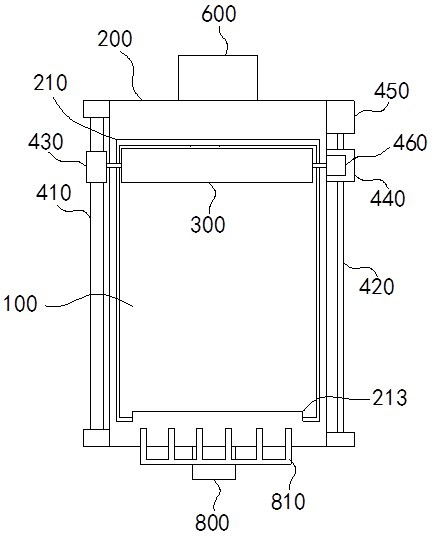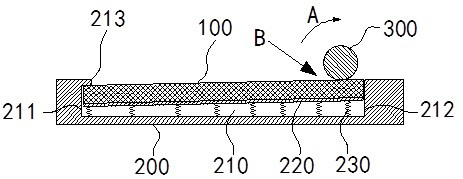Honey plant pest control device and method
A technology for the control of nectar plants and pests, which is applied in the field of pest control devices for nectar plants, and can solve problems such as inability to use sulfoxaflor, acute poisoning of bees, and negative effects on bee reproductive ability
- Summary
- Abstract
- Description
- Claims
- Application Information
AI Technical Summary
Problems solved by technology
Method used
Image
Examples
Embodiment 1
[0035] figure 1 It is a schematic diagram of the side structure of the honey plant pest control device 010 provided in this embodiment. figure 2 The C-direction view of the honey plant pest control device 010 provided in this embodiment. image 3 A schematic diagram of the internal structure of the positioning plate 200 in the honey plant pest control device 010 provided in this embodiment. Please refer to Figure 1-Figure 3 The honey plant pest control device 010 provided in this embodiment includes an insect trap 100 , a positioning plate 200 , a grinding roller 300 , a driving device, an air compressor 800 , a control device 600 and a support rod 700 .
[0036] The insect trap 100 is used to lure aphids to eat and poison them, and its specific composition will be described in detail later. In this embodiment, the insect trap 100 is a rectangular plate structure with a length of 40 cm and a width of 25 cm.
[0037]The lower side of the positioning plate 200 is fixedly c...
Embodiment 2
[0056] This embodiment is basically the same as Embodiment 1, except that the composition of the insect trap 100 is different.
[0057] In this embodiment, when making the insect trap 100, cotton leaves, rape leaves, green peppers, aster petals and crape myrtle petals were respectively soaked in sulfoxaflor solution of 6.5% by mass for 37 minutes and then dried in the air .
[0058] In this embodiment, in the insect-attracting board 100 , the weight ratio of the mixed insect-attracting powder to the edible glue is 6.5:1.
[0059] In the present embodiment, in the mixed insect-attracting powder, by weight, there are 47 parts of cotton leaves, 36 parts of rape flower leaves, 14 parts of green peppers, 8 parts of aster petals, and 10 parts of crape myrtle petals.
Embodiment 3
[0061] This embodiment is basically the same as Embodiment 1, except that the composition of the insect trap 100 is different.
[0062] In this embodiment, when making the insect trap 100, cotton leaves, rapeseed leaves, green peppers, aster petals and crape myrtle petals were respectively soaked in 8% by mass sulfoxaflor solution for 45 minutes and then dried in the air .
[0063] In this embodiment, in the insect-attracting board 100 , the weight ratio of the mixed insect-attracting powder to the edible glue is 8:1.
[0064] In the present embodiment, in the mixed insect-attracting powder, by weight, there are 53 parts of cotton leaves, 42 parts of rape flower leaves, 16 parts of green peppers, 10 parts of aster petals, and 14 parts of crape myrtle petals.
PUM
 Login to View More
Login to View More Abstract
Description
Claims
Application Information
 Login to View More
Login to View More - R&D
- Intellectual Property
- Life Sciences
- Materials
- Tech Scout
- Unparalleled Data Quality
- Higher Quality Content
- 60% Fewer Hallucinations
Browse by: Latest US Patents, China's latest patents, Technical Efficacy Thesaurus, Application Domain, Technology Topic, Popular Technical Reports.
© 2025 PatSnap. All rights reserved.Legal|Privacy policy|Modern Slavery Act Transparency Statement|Sitemap|About US| Contact US: help@patsnap.com



